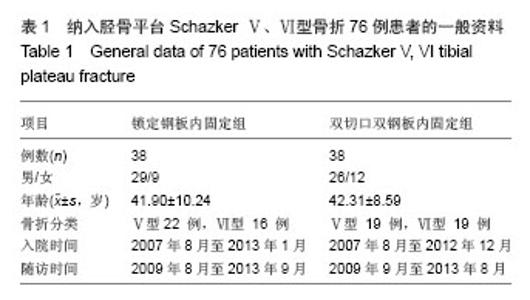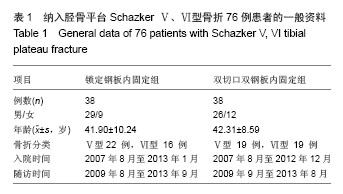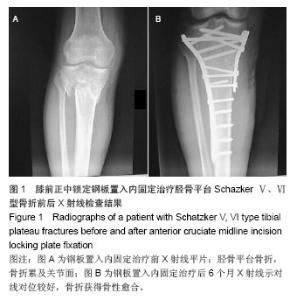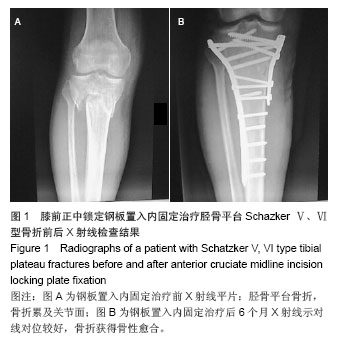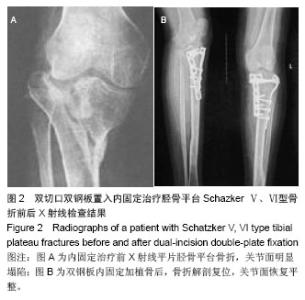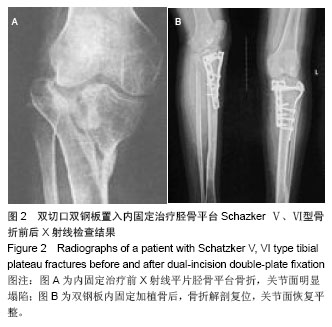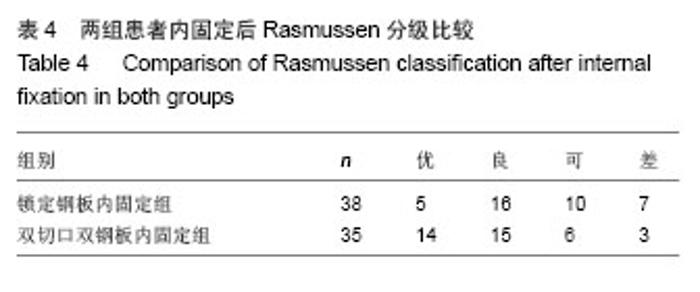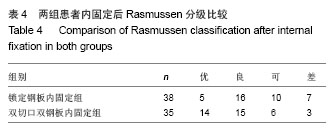| [1]冯万文,夏亚一,徐杏荣,等.经双切口入路手术治疗胫骨平台双髁骨折[J].中国矫形外科杂志,2011,19(20):1693-1696.
[2]Bozic KJ, Kurtz SM, Lau E, et al. The epidemiology of revision total hip arthroplasty in the United States. J Bone Joint Surg Am. 2009;91(1):128-133.
[3]谢晶晶,宋烜,王占朝,等. 内外侧锁定钢板固定胫骨远端骨折的比较[J].中国组织工程研究,2013,17(43):7636-7641.
[4]蒲志超,谢伟勇,何灿杰,等.负压封闭引流技术联合外固定支架外固定治疗合并骨筋膜室综合征的胫骨平台骨折[J].中医正骨, 2012, 24(8):32-34.
[5]Tei K, Kubo S, Matsumoto T, et al. Combined osteochondral fracture of the posterolateral tibial plateau and Segond fracture with anterior cruciate ligament injury in a skeletally immature patient. Knee Surg Sports Traumatol Arthrosc. 2012;20(2):252-255.
[6]陈勇,任可,孙国静,等.胫骨平台骨折外侧髁分型及其临床意义[J].中国骨与关节损伤杂志,2011,26(8):702-704.
[7]Chan YS. Arthroscopy-assisted surgery for tibial plateau fractures. Chang Gung Med J. 2011;34(3):239-247.
[8]Stannard JP, Lopez R, Volgas D. Soft tissue injury of the knee after tibial plateau fractures. J Knee Surg. 2010;23(4):187-192.
[9]胡超,张桃根,蔡林胫骨平台骨折的治疗现状[J]中国骨与关节损伤杂志,2012, 27(2):191-192.
[10]晏林,吴雷.锁定钢板内固定治疗复杂胫骨平台骨折疗效分析[J].重庆医学,2012,41(30):3169-3171.
[11]Peltola EK, Mustonen AO, Lindahl J, et al. Segond fracture combined with tibial plateau fracture. Lindahl J. 2011;197(6): 1101-1104.
[12]黄永梁,周园园.T形骨块植骨结合锁定钢板治疗胫骨平台骨折[J].临床骨科杂志,2014,17(1):115.
[13]Veitch SW, Stroud RM, Toms AD. Compactionbone graftingin tibial plateau fracture fixation. J Trauma. 2010;68(4):980-983.
[14]魏尧森,张立岩,刘斌,等. 锁定钢板内固定治疗胫骨平台骨折[J].临床骨科杂志,2011,14(2):143-144.
[15]Pernaa K, Koski I, Mattila K, et al. Bioactive glass S53P4 and autograft bone in treatment of depressed tibial plateau fractures - a prospective randomized 11-year follow-up. J Long Term Eff Med Implants. 2011;21(2):139-148.
[16]王芳,史法见,赵晓龙. 锁定钢板治疗复杂胫骨平台骨折的疗效和安全性分析[J]. 组织工程与重建外科杂志,2013,9(5): 273-275.
[17]Peltola EK, Mustonen AO, Lindahl J, et al. Segond fracture combined with tibial plateau fracture. AJR Am J Roentgenol. 2011;197(6):1101-1104.
[18]Arjona-Giménez C, Navarrete-Jiménez JD,Nieto-Rodríguez O. Lobenhoffer approach to stabilize fractures of the posteromedial tibial plateau. Acta Ortop Mex. 2013;27(6): 380-384.
[19]刘宗超,蒋燕,杨家福,等.有限内固定结合外固定支架与钢板治疗胫骨平台骨折的疗效分析[J].中国矫形外科杂志,2012,20(6): 505-508.
[20]杨超.胫骨近端关节内骨折不同植入物内固定的比较[J].组织工程与重建外科杂志, 2013,9(48):8407-8412.
[21]Vasanad GH, Antin SM, Akkimaradi RC, et al. "Surgical management of tibial plateau fractures - a clinical study". J Clin Diagn Res. 2013;7(12):3128-3130.
[22]童卫华,刘浩,郭彩群,等.锁定钢板与普通解剖型钢板置入治疗复杂胫骨平台骨折的疗效和安全性比较[J].海南医学,2013, 24(22):3311-3313.
[23]蔡伟斌,胡鸿璇,郭新辉,等.锁定加压钢板与解剖钢板置入内固定治疗复杂胫骨平台骨折[J].中国组织工程,2012,16(6): 9750-9755.
[24]Ferreira N, Marais LC. Bicondylar tibial plateau fractures treated with fine-wire circular external fixation. Strategies Trauma Limb Reconstr. 2014;9(1):25-32.
[25]陈志伟,刘春磊,罗俊标,等.手术治疗累及后髁的复杂性胫骨平台骨折[J].实用骨科杂志,2011,17(5):402-403,407.
[26]Albuquerque RP, Hara R, Prado J, et al. Epidemiological study on tibial plateau fractures at a level I trauma center. Acta Ortop Bras. 2013;21(2):109-115.
[27]章建卫,刘曦明,蔡贤华,等.单侧钢板治疗Schatzker Ⅵ型胫骨平台骨折的疗效分析[J].创伤外科杂志,2013,15(3):201-204.
[28]Dall'oca C, Maluta T, Lavini F,et al. Tibial plateau fractures: compared outcomes between ARIF and ORIF. Strategies Trauma Limb Reconstr. 2012;7(3):163-175.
[29]陈之青,谢金兔,李坚,等.双切口双钢板及三切口三钢板内固定治疗双柱及三柱损伤的复杂胫骨平台骨折[J].浙江创伤外科, 2013,18(5):661-663.
[30]Flautt W, Miller J,Ratcliff JR. Lateral tibial plateau fracture. J Orthop Sports Phys Ther. 2012;42(9):819.
[31]Werner CM, Scheyerer MJ, Schmitt J, et al. Minimally invasive balloon-assisted reduction and internal fixation of tibial plateau fractures. Unfallchirurg. 2012;115(12): 1126-1132. |
